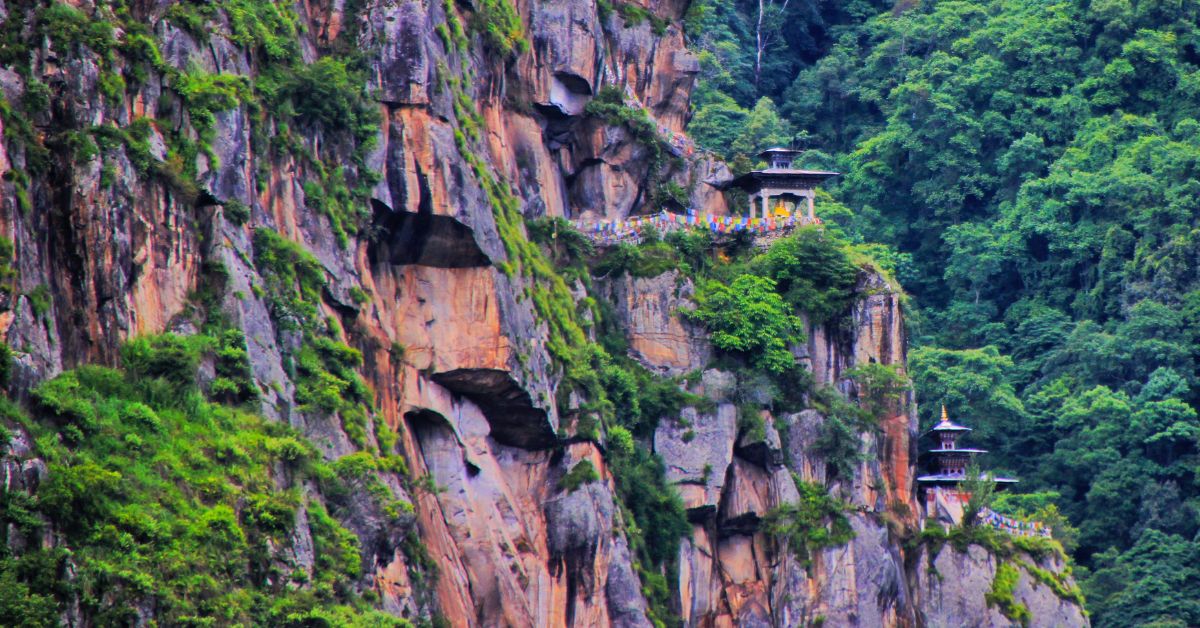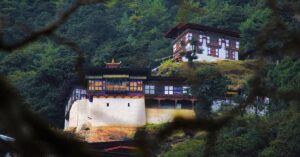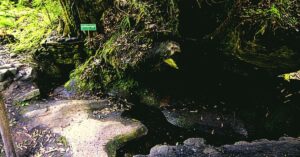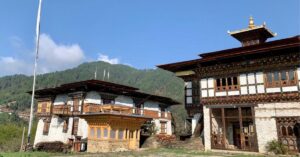Omba Ney, the “Taktsang of East,” is the first of three sacred sites of Guru Rinpoche where the letter “OM” is seen on the rock face. The Omba Lhakhang is built on a cliff at an altitude of 2300 masl in Toedtsho Gewog under the Tashiyantse Dzongkhag, just like the famous Paro Taktsang.
The mantra syllable OM AH HUNG is believed to have been hidden separately in different places. OM is in Trashiyangtse as Omba Ney, which is said to host 100 OM. AH in Mongar as Aja Ney with 100 AH and HUNG in Mongar Sheridzong as Hungja Ney with 100 Hung. A visit to Omba Nye is the equivalent of visiting the Tiger’s Nest.
Some sources have it that the Ney should have been called Om Ja instead of Om Ba, which means ‘the hidden Om’. However, people claim that they can see Om and Ba separately today.
Also Read: The Three Sacred Sites of Guru Rinpoche, which form the Buddhist Mantra, “Om Ah Hung”
How to Reach Omba Ney
Drive 2 hours from Trashiyangtse or Trashigang to the parking. The hike to the Ney takes about 3 hours from Nangkhar Goenpa parking, beginning with a 330-meter steep descent, followed by a 125-meter steady climb.
The other route is from Kheni village. After a one-hour climb from Kheni village, you can reach Omba Ney. Kheni village is a few minutes from the Toedtsho Gewog office.
Also Read: How to Reach Aja Ney, a Sacred Site of a Hundred Inscriptions of the Syllable ‘Aa’
Sacred Relics to See at Omba Nye
- Taktsang of Eastern Bhutan;
- The self-arisen letter Om on the rock face;
- A narrow passage of the cave to cleanse our defilement;
- Footprint of Guru Rinpoche;
- A statue of Guru Rinpoche;
- Omba Lhakhang.
Also Read: Guru Rinpoche in Bhutan: His Visits to Bhutan and Sacred Sites
Historical Significance of Omba Ney
According to the Omba Nye history, Guru Rinpoche had meditated here for 2 months, subduing the demon Phurba Trashi. It is also said that Omba Ney was blessed while Guru Rimpoche pursued the demon residing at Gom Kora. This sacred place has the letter “OM” on the rock face.
Among Bhutan’s many sacred sites, Omba Ney is the first of three holy sites connected to Guru Rinpoche, with the second being Aja Ney and the third being Hungrel Dzong, which features the letters Aa and Hung, which together form the three holy syllables of the mantra “Om Aa Hung.” Omba Ney is one of the Om Ah Hung Ney of Guru Rinpoche.
Despite being the holiest place of all these hidden treasures, Om Ba Ney was not known until Terton Guru Choewang opened it to the public. Terton Guru Choewang traveled from Kurtoe Nyalamdung to Trashiyangtse, where Omba Ney was hidden. On arriving there, he pointed out that “AH” is in Aja Nye and “Om” is here, while “Hung” is in Mon Kha Sheridzong.
Later, Terton Pema Lingpa journeyed from Bumthang to Tawang via Om Ba Ney to give teachings. He spent several days at Om Ba Ney and further recognized the sacredness of Om Ba Ney.
Terton Pema Lingpa’s granddaughter, Ani Choeten Zangmo, also meditated at the Ney and identified many hidden treasures. Ani Cheten Zangmo was born in Bumthang Kunzang Drak. She then moved to Trashiyangtse and founded Shakshing Goenpa as her summer residence and Darchen Goenpa as her winter residence.
Also Read: “Om Ah Hung” Ney of Guru Rinpoche in Bhutan
Importance of Omba Nye
Why is Omba Nye important? Omba Nye is important as it is one of the three holy places linked to Guru Padmasambhava, the saint who introduced Buddhism in Bhutan. This site was blessed by Guru Rinpoche, who meditated there for two months to subdue a demon and spread the Buddha Dharma. This site features the inscription of the sacred syllable “Om Ah Hung” on a rock face, considered a symbol of wisdom, speech, and mind. This inscription is believed to have been imprinted by Guru Rinpoche during his visit to the site.
Description of Omba Nye
Om Ba Ney has a high mountain at the back and low hills in the front, with smaller hills looking as if hanging like curtains. And from left and right flows Phochu and Mochu, making peaceful and wrathful rhythms. There are temples, caves, and various sites of religious importance nearby left by Guru Rinpoche as you ascend to the top of the Ney.
Crawling through a narrow cave passage on the cliff above the Temple is said to cleanse one’s defilement.
The letter Om on the rock face, which has appeared naturally, is the main attraction. The footprint of Guru Rinpoche is also a part of the wonders that will leave you venerated.
Omba Lhakhang, also known as the “Taktsang of Eastern Bhutan,” is built on a cliff. There is a magnificent Guru statue just above the temple!
Also Read: Paro Taktsang (Tiger’s Nest), the Sacred Place of Guru Rinpoche’s Enlightened Mind
Accommodation at Omba Ney
There is a homestay for your wonderful pilgrimage memories if you trek to Omba Ney. Omba Homestay is the only homestay in the area. The homestay doesn’t have a fixed rate for now. So, call 17664632 and make the owner welcome you into their homestay. You can camp in the village of Omba, which has lovely camping sites for the night. You can contact the site manager, Sonam Peldon, at 17365573 or the caretaker Neten at 17612433.
Best Time to Visit Omba Ney
You can visit the Ney all year because the area is one of the driest in the region, with rain falling mostly at night. Be sure to hike in proper hiking boots as the terrain is rough. Carry rain gear as this part of the country experiences heavy summer and early autumn rainfall. If you’re looking for the best time to travel, the best time to visit is from March to April. You can visit the major pilgrimage sites of Trashiyangtse with the Bhutan Pilgrimage Package.
Places to Explore in Trashiyangtse
Chorten Kora: A stupa built by Lama Ngawang Lodro in 1740 AD. The stupa is modeled after the famous Boudha Stupa in Nepal.
Gomphu Kora: It is a sacred pilgrimage site, where Guru Padmasambhava meditated in a rock cave and subdued an evil spirit in the 8th century.
Gongza Ney: A revered site where Khandro Yeshey Tshogyal offered him tea at noontime.
Rigsum Goenpa: A monastery founded in the 18th century by Lama Tshering Gyamtsho, which guards Bhutan’s sovereignty from the north.
Pemaling Ney: A holy pilgrimage destination where Guru Rinpoche had meditated.
Dechenphodrang Ney: A hidden place of peace and refuge blessed by Guru Padmasambhava in the 8th century.
Frequently Asked Questions
Why Omba Nye is important?
Omba Nye is important as it is one of the three holy places linked to Guru Padmasambhava, the saint who introduced Buddhism in Bhutan. This site was blessed by Guru Rinpoche, who meditated there for two months to subdue a demon and spread the Buddha Dharma.
Enjoyed reading this blog?




